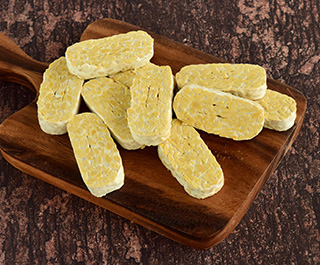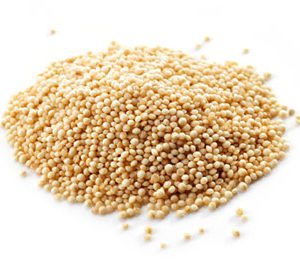In terms of meat substitutes, tempeh definitely stands out, not only because of its versatility, but also for its meat-like texture that can certainly fool anyone who’s not looking closely.
Whether you’re vegetarian or not, you can definitely benefit from adding tempeh to your diet. Get to know more about this unique food and how it can boost your health.
What Is Tempeh?
With a long history dating back to ancient Asian civilizations, particularly in Indonesia, tempeh is a type of “vegetarian meat” made from fermented soybeans.
The beans are soaked in water to soften, and then cooked, fermented and formed into a firm and dense patty or block. During the incubation process, a thick and white mat of fungus, called a mycelia, branches over the beans and binds them together.
Tempeh has been in existence for a long time. In fact, the “Serat Centhini,” a compilation of Javanese teachings and stories, has records of this food being enjoyed as early as the 16th century. It was even described as “the oldest food technology in the history of the Javanese people.”
Despite being made from bland soybeans, tempeh actually has a unique taste. It has a strong and nutty flavor, and a dry, firm and chewy texture that holds very well during cooking. It can be steamed, sautéed, fried or even baked. Oftentimes, it’s marinated to allow it to soak in more flavor.
What’s more, tempeh can absorb the flavor of the sauces or foods it’s cooked with, which is why it’s a very versatile choice to suit various dishes. Whether it’s for main courses like chili, curry or stew, or for snacks like veggie burgers, sandwiches or even tacos, tempeh can blend in beautifully.
While traditionally made from soybeans, other ingredients may also be used to produce tempeh. Chickpeas, black-eyed beans, black beans are other options. Some varieties also use seeds and grains like barley, brown rice or millet.
Tempeh Versus Tofu: Which Is Better?
Many people think that they can interchange tofu and tempeh in recipes. After all, they both come from soybeans and they’re both high in protein. However, that’s where their similarities end.
First of all, tofu is not fermented, and is made by allowing milk to coagulate and then pressing and molding the curd into blocks. Meanwhile, tempeh is fermented with a starter culture and uses whole soybeans. In terms of texture, tofu is generally soft, albeit sold in varying levels of firmness – from silken to extra firm. However, tempeh is dry and has a firm, meat-like texture.
Finally, tempeh outshines tofu in terms of flavor, as it’s savory, nutty and earthy, almost like mushrooms. Tofu, on the other hand, is very subtly flavored and is bland – it relies on marinades or other ingredients to give it flavor.
But perhaps the biggest benefit of tempeh over tofu is that it’s fermented. Tofu is a type of unfermented soy, which can be dangerous as it contains antinutrients, like phytic acid, trypsin inhibitors and phytoestrogens, which can hinder the absorption of essential minerals like zinc, iron, calcium, magnesium and copper. In tempeh, however, fermentation greatly minimizes these antinutrients, and instead makes beneficial nutrients available to your digestive system.
Tempeh’s Many Health Benefits
One of the biggest benefits you can obtain from tempeh is its high protein content, which can help maintain muscle tissue and assist in producing enzymes needed by the cells for optimal function. What’s more, the protein in tempeh is more digestible compared to proteins from animal products. This is all thanks to the fermentation process, which converts the protein into amino acids. Other nutrients you can get from tempeh include:
- Riboflavin and niacin: These two B vitamins provide metabolic support by activating enzymes that are essential to proper metabolism. In addition, niacin helps curb your appetite, while riboflavin improves your eye and skin health.
- Copper and manganese: These minerals promote tissue strength by improving collagen synthesis, as well as helps wounds heal faster. Manganese also helps eliminate glutamate, a nerve toxin, from your brain, while copper boosts communication between brain cells.
- Other B vitamins: Vitamin B6, folate, vitamin B12 and pantothenic acid are also found in tempeh. They are all essential for cellular growth and development, as well as regulating enzymes and proteins. Not getting enough of these vitamins can lead to depression, anemia, respiratory infections, fatigue and more.
- Healthy fats: Tempeh contains both omega-3 and omega-6 fatty acids, which are responsible for boosting heart health and reducing triglyceride levels, and stabilizing blood pressure and regulating metabolic function, respectively.
In addition, tempeh provides you with dietary fiber that helps bind to toxins in the colon, so they can be eliminated from the body.
Different Ways to Cook Tempeh
How you cook tempeh depends on what type of dish you’re planning to add it to. Here are five ways to prepare tempeh, according to The Kitchn:
- Steamed: Slice the tempeh and place in a saucepan, and cover with broth or water. Let the liquid boil, then reduce heat and let simmer for 10 minutes. Remove, and then use in recipes.
- Marinated: You can use various types of marinades to complement tempeh’s nutty flavor. Vinegar, coconut milk, citrus juice, spices, ginger and raw honey are some good choices. Marinated tempeh can be fried, baked or grilled.
- Sliced thinly and fried or grilled: This is another way to enhance the nuttiness of tempeh. By frying or grilling it until its edges become crispy, but still leaving its interior chewy, tempeh’s unique flavor will stand out.
- Crumbled into stews, salads or sauces: It can be a subtle way to add protein to a meal. Add crumbled, cubed or grated tempeh to curry, stew or spaghetti sauces, or sprinkle it over your favorite salad.
- Blackened and spiced: Coating tempeh with blackening spice or a Cajun-style seasoning before pan-searing it will heighten its flavor profile. Add this to your vegetable bowls or salads.
Tempeh Nutrition Facts
| Tempeh Nutrition Facts
Serving Size: 100g |
||
| Amt. Per Serving |
% Daily Value* |
|
| Calories | 192 kcal | 10% |
| Calories from Fat | ||
| Total Fat | 10.8 g | 17% |
| Saturated Fat | 2.5 g | 13% |
| Trans Fat | 0 g | |
| Cholesterol | 0 mg | 0% |
| Sodium | 9 mg | 0% |
| Total Carbohydrates | 7.6 g | 3% |
| Dietary Fiber | 3.7 g | 15% |
| Sugar | 2.7 g | |
| Protein | 20.3 g | 41% |
| Vitamin A | 0% | |
| Calcium | 11% | |
*Percent Daily Values are based on a 2,000 calorie diet. Your daily values may be higher or lower depending on your calorie needs.
You’ll Never Run Out of Uses for Tempeh
Tempeh may be one of those foods you never give a second glance at while you’re buying groceries, but that’s something you might want to change. Compared to other soybean products like tofu, it’s definitely a much healthier fare, thanks to the fermentation process responsible for its unique flavor and texture.
Not only that, but tempeh is also loaded with nutrients, including B vitamins, copper and manganese, as well as fiber and protein. The next time you’re craving a hearty, meaty dish, give tempeh a shot – it might become your new favorite.
Frequently Asked Questions (FAQs) About Tempeh
Q: What is tempeh made of?
- Tempeh is made from fermented soybeans. The beans are first soaked to soften them, before they are cooked and fermented, so they will form a firm and dense patty. While being incubated, the soybeans form a thick and white mat of fungus, called a mycelia. It branches over the beans and binds them together.
- What does tempeh taste like?
- Tempeh has a unique and savory flavor. It’s nutty and earthy, and is almost reminiscent of mushrooms. It also has a dry and firm texture, which is very similar to meat.
- Is tempeh gluten free?
- While there are brands of tempeh that are gluten-free, some are not. Before purchasing, look at the food label to see if it says “gluten-free” or if it says “contains wheat.”







Reviews
There are no reviews yet.